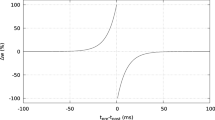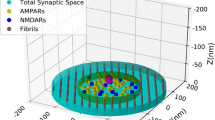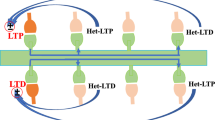Abstract
Synaptic transmission is the key system for the information transfer and elaboration among neurons. Nevertheless, a synapse is not a standing alone structure but it is a part of a population of synapses inputting the information from several neurons on a specific area of the dendritic tree of a single neuron. This population consists of excitatory and inhibitory synapses the inputs of which drive the postsynaptic membrane potential in the depolarizing (excitatory synapses) or depolarizing (inhibitory synapses) direction modulating in such a way the postsynaptic membrane potential. The postsynaptic response of a single synapse depends on several biophysical factors the most important of which is the value of the membrane potential at which the response occurs. The concurrence in a specific time window of inputs by several synapses located in a specific area of the dendritic tree can, consequently, modulate the membrane potential such to severely influence the single postsynaptic response. The degree of modulation operated by the synaptic population depends on the number of synapses active, on the relative proportion between excitatory and inbibitory synapses belonging to the population and on their specific mean firing frequencies. In the present paper we show results obtained by the simulation of the activity of a single Glutamatergic excitatory synapse under the influence of two different populations composed of the same proportion of excitatory and inhibitory synapses but having two different sizes (total number of synapses). The most relevant conclusion of the present simulations is that the information transferred by the single synapse is not and independent simple transition between a pre- and a postsynaptic neuron but is the result of the cooperation of all the synapses which concurrently try to transfer the information to the postsynaptic neuron in a given time window. This cooperativeness is mainly operated by a simple mechanism of modulation of the postsynaptic membrane potential which influences the amplitude of the different components forming the postsynaptic excitatory response.






Similar content being viewed by others
References
Allam SL, Bouteiller JMC, Hu EY, Ambert N, Greget R, Bischoff S, Baudry M, Berger TW (2015) Synaptic efficacy as a function of ionotropic receptor distribution: a computational study. PLoS ONE 10:1–20. https://doi.org/10.1371/journal.pone.0140333
Arac D, Boucard AA, Ozkan E, Strop P, Newell E, Südhof TC, Brunger AT (2007) Structures of neuroligin-1 and the neuroligin-1/neurexin-1 beta complex reveal specific protein-protein and protein-ca 2+ interactions. Neuron 56:992–1003
Araya R, Jiang J, Eisenthal KB, Yuste R (2006) The spine neck filters membrane potentials. Proc Natl Acad Sci USA 103:17961–17966. https://doi.org/10.1073/pnas.0608755103
Araya R, Vogels TP, Yuste R (2014) Activity-dependent dendritic spine neck changes are correlated with synaptic strength. Proc Natl Acad Sci USA 111(28):E2895–904. https://doi.org/10.1073/pnas.1321869111
Arellano JI, Benavides-Piccione R, Defelipe J, Yuste R (2007) Ultrastructure of dendritic spines: correlation between synaptic and spine morphologies. Frontiers Neurosci https://doi.org/10.3389/neuro.01.1.1.010.2007
Averbeck BB, Latham PE, Pouget A (2006) Neural correlations, population coding and computation. Nat Rev Neurosci 7:358–366. https://doi.org/10.1038/nrn1888
Baudry M, Zhu G, Liu Y, Wang Y, Briz V, Bi X (2015) Multiple cellular cascades participate in long-term potentiation and in hippocampus-dependent learning. Brain Res 1631:73–81. https://doi.org/10.1016/j.brainres.2014.11.033
Beierlein M (2014) Chapter 17–cable properties and information processing in dendrites. In: Byrne JH, Heidelberger R, Waxham MN (eds) From Molecules to Networks, 3rd edn. Academic Press, Boston, pp 509–529
Bennett TL, Hbert PN, Moss DE (1973) Hippocampal theta activity and the attention component of discrimination learning. Behav Biol 8:173–181. https://doi.org/10.1016/S0091-6773(73)80017-3
Bliss T, Collingridge G (2013) Expression of nmda receptor-dependent ltp in the hippocampus: bridging the divide. Mol Brain 6:1–14
Bourne JN, Harris KM (2011) Coordination of size and number of excitatory and inhibitory synapses results in a balanced structural plasticity along mature hippocampal ca1 dendrites during ltp. HIPPOCAMPUS 21:354–373. https://doi.org/10.1002/hipo.20768
Eberhard BuhK, Halasy Hand, Somogyi P (1994) Diverse sources of hippocampal unitary inhibitory postsynaptic potentials and the number of synaptic release sites. Nature 368:823–828
Buzsáki G (2002) Theta oscillations in the hippocampus. Neuron 33:325–340. https://doi.org/10.1016/S0896-6273(02)00586-X
Clements JD (1996) Transmitter timecourse in the synaptic cleft: its role in central synaptic function. Trends Neurosci 19:163–171
Clements JD, Lester R, Tong G, Jahr CE, Westbrook GL (1992) The time course of glutamate in the synaptic cleft. Science 258:1498–1501. https://doi.org/10.1126/science.1359647
Cory SM, Glavinovic MI (2006) Molecular dynamics simulations of glutamate diffusion in synaptic cleft. Crit Rev Neurobiol 18(1–2):61–9. https://doi.org/10.1615/CritRevNeurobiol.v18.i1-2.70
Di Maio V (2019) The origins of variability in the responses of the glutamatergic synapse. Biomed J Sci Techn Res 23:17662–17666 https://doi.org/10.26717/BJSTR.2019.23.003947
Di Maio V, Santillo S (2020) Information processing and synaptic transmission. In: Vinjamuri DR (ed) Advances in Neural Signal Processing. IntechOpen, London
Di Maio V, Ventriglia F, Santillo S (2016a) AMPA/NMDA cooperativity and integration during a single synaptic event. J Comput Neurosci 41:127–142
Di Maio V, Ventriglia F, Santillo S (2016b) A model of cooperative effect of ampa and nmda receptors in glutamatergic synapses. Cogn Neurodyn 10:315–325
Di Maio V, Ventriglia F, Santillo S (2017) Stochastic, structural and functional factors influencing ampa and nmda synaptic response variability: a review. Neuronal Signal 1:1–11. https://doi.org/10.1042/NS20160051
Di Maio V, Santillo S, Sorgente A, Vanacore P, Ventriglia F (2018a) Influence of active synaptic pools on the single synaptic event. Cogn Neurodyn 12:391–402. https://doi.org/10.1007/s11571-018-9483-3
Di Maio V, Santillo S, Ventriglia F (2018b) Multisynaptic cooperation shapes single glutamatergic synapse response. Brain Res 1697:93–104. https://doi.org/10.1016/j.brainres.2018.06.016
Dingledine R, Borges K, Bowie D, Traynelis S (1999) The gutamate receptor ion channels. Pharmacol Rev 51:7–61
Dobrunz LE, Stevens CF (1997) Heterogeneity of release probability, facilitation, and depletion at central synapses. Neuron 18:995–1008
D’Onofrio G, Lánský P, Tamborrino M (2019) Inhibition enhances the coherence in the jacobi neuronal model. Chaos Solitons Fractals 128:108–113. https://doi.org/10.1016/j.chaos.2019.07.040
Forti L, Bossi M, Bergamaschi A, Villa A, Malgaroli A (1997) Loose path recording of single quanta at individual hippocampal synapses. Nature 388:874–878
Gardoni F, Di Luca M (2015) Targeting glutamatergic synapses in parkinson’s disease. Curr Opin Pharmacol 20:24–28. https://doi.org/10.1016/j.coph.2014.10.011
Glavinovic MI (1999) Monte carlo simulation of vesicular release, spatiotemporal distribution of glutamate in synaptic cleft and generation of postsynaptic currents. Pflügers Arch : Eur J Physiol 437:462–470
Gonzlez MI, Grabenstatter HL, Cea-Del Rio CA, Cruz Del Angel Y, Carlsen J, Laoprasert RP, White AM, Huntsman MM, Brooks-Kayal A (2015) Seizure-related regulation of gabaa receptors in spontaneously epileptic rats. Neurobiol Dis 77:246–256. https://doi.org/10.1016/j.nbd.2015.03.001
Gray R, Johnston D (1985) Rectification of single gaba-gated chloride channels in adult hippocampal neurons. J Neurophysiol 54(1):134–142. https://doi.org/10.1152/jn.1985.54.1.134
Greger IH, Ziff EB, Penn AC (2007) Molecular determinants of ampa receptor subunit assembly. Trends Neurosci 30(8):407–16. https://doi.org/10.1016/j.tins.2007.06.005
Grunditz A, Holbro N, Tian L, Zuo Y, Oertner TG (2008) Spine neck plasticity controls postsynaptic calcium signals through electrical compartmentalization. J Neurosci 28(50):13457–13466. https://doi.org/10.1523/JNEUROSCI.2702-08.2008
Guerrier C, Holcman D (2018) The first 100 nm inside the pre-synaptic terminal where calcium diffusion triggers vesicular release. Frontiers Synaptic Neurosci 10:23. https://doi.org/10.3389/fnsyn.2018.00023
Gulledge AT, Carnevale NT, Stuart GJ (2012) Electrical advantages of dendritic spines. PLoS ONE 7:1–17. https://doi.org/10.1371/journal.pone.0036007
Gulyás AI, Megías M, Emri Z, Freund TF (1999) Total number and ratio of excitatory and inhibitory synapses converging onto single interneurons of different types in the ca1 area of the rat hippocampus. J Neusci 19:10082–10097
Guo D, Wang Q, Perc Mcv (2012) Complex synchronous behavior in interneuronal networks with delayed inhibitory and fast electrical synapses. Phys Rev E 85:061905–1–061905-8. https://doi.org/10.1103/PhysRevE.85.061905
Han X, Jackson MB (2006) Structural transitions in the synaptic snare complex during \(ca^{2+}\) triggered exocytosis. J Cell Biol 172:281–293. https://doi.org/10.1083/jcb.200510012
Hanse E, Gustafsson B (2001) Quantal variability at glutamatergic synapses in area ca1 of the rat neonatal hippocampus. J Physiol 531:467–480
Harnett MT, Makara JK, Spruston N, Kath WL, Magee JC (2012) Synaptic amplification by dendritic spines enhances input cooperativity. Nature 491:599–602. https://doi.org/10.1038/nature11554
Husser M (2001) Synaptic function: Dendritic democracy. Curr Biol 11:R10–R12. https://doi.org/10.1016/S0960-9822(00)00034-8
Jahr C, Stevens C (1990) Voltage dependence of nmda-activated macroscopic conductances predicted by single-channel kinetics. J Neurosci 10:3178–3182
Jonas P, Sakmann B (1992) Glutamate receptor channels in isolated patches from ca1 and ca3 pyramidal cells of rat hippocampal slices. J Physiol 455(1):143–171. https://doi.org/10.1113/jphysiol.1992.sp019294
Klausberger T, Magill PJ, Marton LF, Roberts JDB, Cobden PM, Buzsáki G, Somogyi P (2003) Brain-state- and cell-type-specific firing of hippocampal interneurons in vivo. Nature 421:844–848
Kokaia M (2000) Long-term potentiation of single subicular neurons in mice. Hippocampus 10:684–692. https://doi.org/10.1002/1098-1063(2000)10:6
Kumar A, Rotter S, Aertsen A (2010) Spiking activity propagation in neuronal networks: reconciling different perspectives on neural coding. Nat Rev Neurosci 11:615–627. https://doi.org/10.1038/nrn2886
Kupper J, Ascher P, Neyton J (1998) Internal \(mg^{2+}\) block of recombinant nmda channels mutated within the selectivity filter and expressed in xenopus oocytes. J Physiol 507:1–12
Kwon T, Sakamoto M, Peterka DS, Yuste R (2017) Attenuation of synaptic potentials in dendritic spines. Cell Rep 20:1100–1110. https://doi.org/10.1016/j.celrep.2017.07.012
Larkman AU, Jack JJ (1995) Synaptic plasticity: hippocampal ltp. Current Opinion Neurobiology 5:324–334
Leranth C, Carpi D, Buzsáki G, Kiss J (1999) The entorhino-septo-supramammillary nucleus connection in the rat: morphological basis of a feedback mechanism regulating hippocampal theta rhythm. Neuroscience 88(3):701–718. https://doi.org/10.1016/S0306-4522(98)00245-0
Li X, Luo S, Xue F (2020) Effects of synaptic integration on the dynamics and computational performance of spiking neural network. Cogn Neurodyn. https://doi.org/10.1007/s11571-020-09572-y
Lisman J (2017) Glutamatergic synapses are structurally and biochemically complex because of multiple plasticity processes: long-term potentiation, long-term depression, short-term potentiation and scaling. Philos Trans R Soc Lond B Biol Sci 372:1–11. https://doi.org/10.1098/rstb.2016.0260
Liu G, Choi S, Tsien RW (1999) Variability of neurotransmitter concentration and nonsaturation of postsynaptic ampa receptors at synapses in hippocampal cultures and slices. Neuron 22:395–409
London M, Häusser M (2005) Dendritic computation. Annual Review. Neurosciences 28:503–532. https://doi.org/10.1146/annurev.neuro.28.061604.135703
Lu WY, Man HY, Ju W, Trimble WS, MacDonald JF, Wang YT (2001) Activation of synaptic nmda receptors induces membrane insertion of new ampa receptors and ltp in cultured hippocampal neurons. Neuron 29:243–54
Majewska A, Tashiro A, Yuste R (2000) Regulation of spine calcium dynamics by rapid spine motility. J Neurosci 20:8262–8268
Malinow R, Malenka RC (2002) Ampa receptor trafficking and synaptic plasticity. Annu Rev Neurosci 25:103–126. https://doi.org/10.1146/annurev.neuro.25.112701.142758
Martin SJ, Grimwood PD, Morris RGM (2000) Synaptic plasticity and memory: an evaluation of the hypothesis. Annu Rev Neurosci 23:649–711. https://doi.org/10.1146/annurev.neuro.23.1.649
Megías M, Emri Z, Freund TF, Gulyás AI (2001) Total number and distribution of inhibitory and excitatory synapses on hippocampal ca1 pyramidal cells. Neuroscience 102:527–540
Meldolesi J (1995) Long-term potentiation. The cell biology connection. Curr Biol 5(9):1006–1008
Molnár E (2011) Long-term potentiation in cultured hippocampal neurons. Seminars Cell Develop Biol 22:506–513. https://doi.org/10.1016/j.semcdb.2011.07.017
Nicoll R, Schmitz D (2005) Synaptic plasticity at hippocampal mossy fibre synapses. Nat Rev Neurosci 6:863–876
Nimchinsky EA, Sabatini BL, Svoboda K (2002) Structure and function of dendritic spines. Annu Rev Physiol 64:313–353
Nuriya M, Jiang J, Nemet B, Eisenthal KB, Yuste R (2006) Imaging membrane potential in dendritic spines. Proc Natl Acad Sci USA 103:786–90. https://doi.org/10.1073/pnas.0510092103
Palmer L, Murayama M, Larkum M (2012) Inhibitory regulation of dendritic activity in vivo. Frontiers Neural Circuitry 6:1–10. https://doi.org/10.3389/fncir.2012.00026
Palmer LM, Stuart GJ (2009) Membrane potential changes in dendritic spines during action potentials and synaptic input. J Neurosci 29:6897–6903. https://doi.org/10.1523/JNEUROSCI.5847-08.2009
Park H, Li Y, Tsien RW (2012) Influence of synaptic vesicle position on release probability and exocytotic fusion model. Science 335:1362–1366. https://doi.org/10.1126/science.1216937
Rall W (1962) Electrophysiology of a dendritic neuron model. Biophys J 2:145–167
Rall W, Rinzel J (1973) Branch input resistance and steady attenuation for input to one branch of a dendritic neuron model. Biophys J 13:648–688
Rao VR, Finkbeiner S (2007) Nmda and ampa receptors: old channels, new tricks. Trends Neurosci 30(6):284–291. https://doi.org/10.1016/j.tins.2007.03.012
Rashid NA, Taib MN, Lias S, Sulaiman N, Murat ZH, Kadir RSSA (2011) Learners learning style classification related to iq and stress based on eeg. Proc Soc Behav Sci 29:1061–1070. https://doi.org/10.1016/j.sbspro.2011.11.339
Raymond CR (2007) Ltp forms 1, 2 and 3: different mechanisms for the long in long-term potentiation. Trends Neurosci 30(4):167–75. https://doi.org/10.1016/j.tins.2007.01.007
Rojas DC (2014) The role of glutamate and its receptors in autism and the use of glutamate receptor antagonists in treatment. J Neuralal Trans 121:891–905. https://doi.org/10.1007/s00702-014-1216-0
Rozsa B, Zelles T, Vizi ES, Lendvai B (2004) Distance-dependent scaling of calcium transients evoked by backpropagating spikes and synaptic activity in dendrites of hippocampal interneurons. J Neurosci 24(3):661–670. https://doi.org/10.1523/JNEUROSCI.3906-03.2004
Rudy CC, Hunsberger HC, Weitzner DS, Reed MN (2015) Synapses and alzheimers disease. Aging Dis 6:131–148 https://doi.org/10.14336/AD.2014.0423
Rumsey CC, Abbott LF (2006) Synaptic democracy in active dendrites. J Neurophysiol 96(5):2307–2318. https://doi.org/10.1152/jn.00149.2006
Sheng M, Sabatini BL, Südhof T (2012) Synapses and alzheimers disease. Cold Spring Harb Perspect Biol 4:1–18. https://doi.org/10.1101/cshperspect.a005777
Sjöström PJ, Turrigiano GG, Nelson SB (2001) Rate, timing, and cooperativity jointly determine cortical synaptic plasticity. Neuron 32(6):1149–1164. https://doi.org/10.1016/S0896-6273(01)00542-6
Smith TC, Wang LY, Howe JR (2000) Heterogeneous conductance levels of native ampa receptors. J Neurosci 20:2073–2085. 10.1523/JNEUROSCI.20-06-02073.2000, https://doi.org/10.1523/JNEUROSCI.20-06-02073.2000
Tabone CJ, Ramaswami M (2012) Is nmda receptor-coincidence detection required for learning and memory? Neuron 74:767–769. https://doi.org/10.1016/j.neuron.2012.05.008
Tichelaar W, Safferling M, Keinänen KHS, Madden DR, (2004) The three-dimensional structure of an ionotropic glutamate receptor reveals a dimer-of-dimers assembly. J Mol Biol 344:435–442. https://doi.org/10.1016/j.jmb.2004.09.048
Tønnesen J, Rózsa G, Katona B, Nägerl U (2014) Spine neck plasticity regulates compartmentalization of synapses. Nat Neurosci 17:678–685
Traynelis S, Wollmuth L, McBain C, Menniti F, Vance K, Ogden K, Hansen K, Yuan H, Myers S, Dingledine R (2010) Glutamate receptor ion channels: structure, regulation, and function. Pharmacol Rev 62:405–496
Treiman DM (2001) Gabaergic mechanisms in epilepsy. Epilepsia 42:8–12. https://doi.org/10.1046/j.1528-1157.2001.042suppl.3008.x
Vargas-Caballero MI, Robinson H (2004) Fast and slow voltage-dependent dynamics of magnesium block in the nmda receptor: the asymmetric trapping block model. J Neuroscit 24:6171–6180
Ventriglia F (2011) Effect of filaments within the synaptic cleft on the response of excitatory synapses simulated by computer experiments. Biosystems 104:14–22
Ventriglia F, Di Maio V (2000a) A brownian model of glutamate diffusion in excitatory synapses of hippocampus. Biosystems 58:67–74
Ventriglia F, Di Maio V (2000b) A brownian simulation model of glutamate synaptic diffusion in the femtosecond time scale. Biol Cybern 83:93–109
Ventriglia F, Di Maio V (2002) Stochastic fluctuation of the synaptic function. Biosystems 67:287–294
Ventriglia F, Di Maio V (2003a) Stochastic fluctuation of the quantal epsc amplitude in computer simulated excitatory synapses of hippocampus. Biosystems 71:195–204
Ventriglia F, Di Maio V (2003b) Synaptic fusion pore structure and ampa receptors activation according to brownian simulation of glutamate diffusion. Biol Cybern 88:201–209
Ventriglia F, Di Maio V (2013a) Effects of ampars trafficking and glutamate-receptor binding probability on stochastic variability of epsc. Biosystems 112:298–304
Ventriglia F, Di Maio V (2013b) Glutamate-ampa interaction in a model of synaptic transmission. Brain Res 1536:168–176
Villa KL, Nedivi E (2016) Excitatory and inhibitory synaptic placement and functional implications. In: Emoto K, Wong R, Huang E, Hoogenraad C (eds) Dendrites. Springer, Japan, pp 467–487, https://doi.org/10.1007/978-4-431-56050-0_18
Volianskis A, France G, Jensen MS, Bortolotto ZA, Jane DE, Collingridge GL (2015) Long-term potentiation and the role of n-methyl-d-aspartate receptors. Brain Res 1621:5–16. https://doi.org/10.1016/j.brainres.2015.01.016
Watt A, Sjstrm PJ, Häusser M, Nelson S, Turrigiano GG (2004) A proportional but slower nmda potentiation follows ampa potentiation in ltp. Nat Neurosci 7:518–524. https://doi.org/10.1038/nn1220
Weber JP, Andrásfalvy BK, Polito M, Magó A, Ujfalussy BB, Makara JK (2016) Location-dependent synaptic plasticity rules by dendritic spine cooperativity. Nat Commun 7:1–14. https://doi.org/10.1038/ncomms11380
Wei H, Dai D, Bu Y (2017) A plausible neural circuit for decision making and its formation based on reinforcement learning. Cogn Neurodyn 11:259–281. https://doi.org/10.1007/s11571-017-9426-4
Wu S, Zhou K, Ai Y, Zhou G, Yao D, Guo D (2020) Induction and propagation of transient synchronous activity in neural networks endowed with short-term plasticity. Cogn Neurodyn. https://doi.org/10.1007/s11571-020-09578-6
Yuste R (2013) Electrical compartmentalization in dendritic spines. Ann Rev Neurosci 36:429–449. https://doi.org/10.1146/annurev-neuro-062111-150455
Zhang H, Wang Q, Perc M, Chen G (2013) Synaptic plasticity induced transition of spike propagation in neuronal networks. Commun Nonlinear Sci Numer Simul 18:601–615. https://doi.org/10.1016/j.cnsns.2012.08.009
Zhang T, Pan X, Xu X, Wang R (2019) A cortical model with multi-layers to study visual attentional modulation of neurons at the synaptic level. Cogn Neurodyn 13:579–599. https://doi.org/10.1007/s11571-019-09540-1
Zito K, Scheuss V (2009) Nmda receptor function and physiological modulation. In: Squire LR (ed) Encyclopedia of neuroscience, vol 6. Academic Press, New York, pp 1157–1164
Zuber B, Nikonenko I, Klauser P, Muller D, Dobochet J (2005) The mammallian central nervous synaptic cleft contains a high density of periodically organized complexes. Proc Natl Acad Sci USA 102:19192–19197
Zusho A, Pintrich PR, Coppola B (2003) Skill and will: The role of motivation and cognition in the learning of college chemistry. Int J Sci Edu 25(9):1081–1094. https://doi.org/10.1080/0950069032000052207
Author information
Authors and Affiliations
Corresponding author
Additional information
Publisher's Note
Springer Nature remains neutral with regard to jurisdictional claims in published maps and institutional affiliations.
Rights and permissions
About this article
Cite this article
Di Maio, V., Santillo, S. & Ventriglia, F. Synaptic dendritic activity modulates the single synaptic event. Cogn Neurodyn 15, 279–297 (2021). https://doi.org/10.1007/s11571-020-09607-4
Received:
Revised:
Accepted:
Published:
Issue Date:
DOI: https://doi.org/10.1007/s11571-020-09607-4




